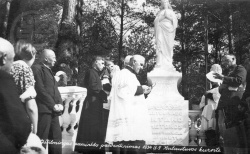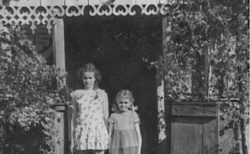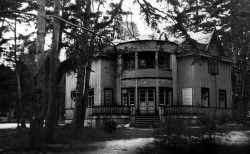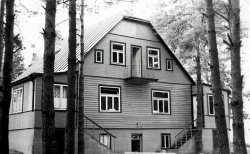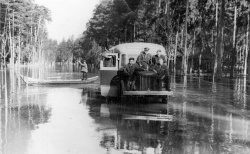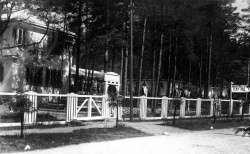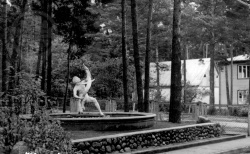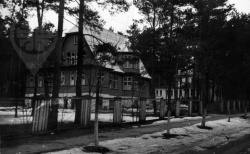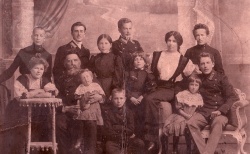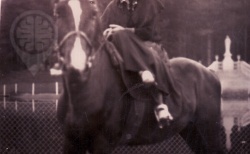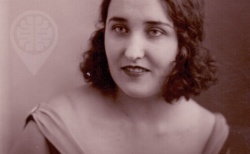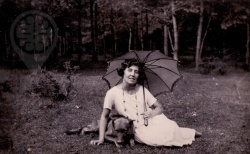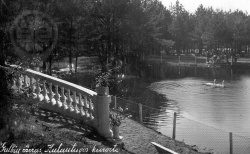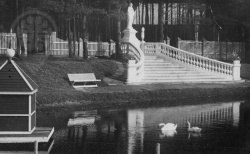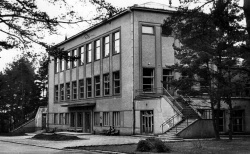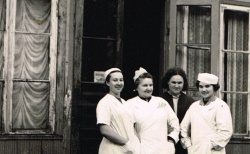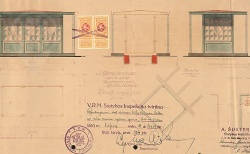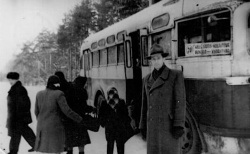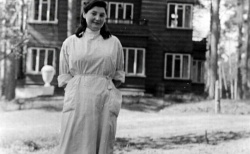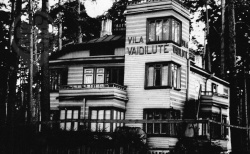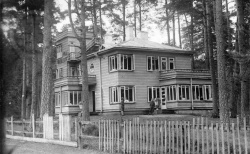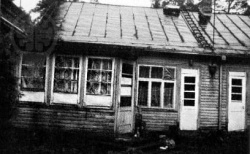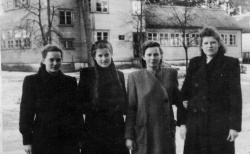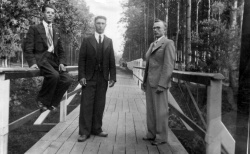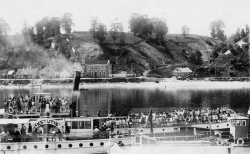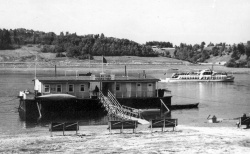About the Route
“In this summer resort of great natural beauty and wellness, one wants to spend not several hours, but several months. All places are overbooked. Holidaymakers are daily entertained by concerts, they can visit a swan with her five cygnets, play basketball, tennis and croquet free of charge every day, go to the cinema in the evenings which is open every day and screens the best movies made in Kaunas and receive the best possible service in Vita Restaurant without feeling overcharged.” This was a playful introduction of Kulautuva in 1939 by Lietuvos Aidas newspaper.
1 House of Jonas Petrauskas
*Aldona:* “I have lived in Kulautuva my entire life. I grew up in a wooden house nearby that was built by my father Jonas Petrauskas and my grandfather. It was the most beautiful resort for me. Decorated windows, shutters and the veranda.
2 Villa „Giedrė“
*Algirdas: *“This villa belonged to Antanas Vaitkevičius, director of the Savings Bank. It was built in 1935. Since the building was nationalised in 1949, the villa was divided into apartments. On the ground floor, since 1951, there was home for Kazimieras Gurauskas, chief doctor of Tuberculosis Sanatorium. Next to the former sanatorium guest room for supervisors from Vilnius and Moscow.”
3 Summer house of Lazaris Černas
*Vincas:* “I grew up in the house of Lazaris Černas. There was the fourth division of Tuberculosis Sanatorium after the war. L. Černas had his medical business, and [my] father looked after his farm. He trusted [my father], asked to purchase building materials. Our entire family lived in the rooms installed in the basement. When I was a child, L. Černas once gave me money so I would buy him cigarettes called Sofo. I tried to remember that word, but when I came to the store, I bought the cheaper ones, Kir, the ones that my father used to smoke. Luckily, Černas was not angry. Unfortunately, he did not manage to run away, the Russians deported him after the war and he did not come back to Kulautuva.
4 Akacijų Avenue
*Albina (1936):* “My dad Kazimieras Sutkus (later Sutkevičius) moved to Kulautuva from Ručkūnai village. He served in the uhlan regiment, managed horses well and was a great singer. When he arrived, he bought a parcel of land and settled. In 1932, he built a house. He built more houses in Kulatuva, he had a business. He was a carpenter, but he liked very much and was successful in building wooden houses. One summer house has remained to this day. Its address is Lelijų Street 1. The Jews liked this place very much. A nice pine forest, on a hill. Constructions used to take place every year, because every summer, there were floods and we had to flow with boats here. Nemunas River would bring us surprises. We did not know whether water will come at night or during the day. Life used to stop for that time.”
5 Villa Vita
*Aldona:* At that time, Vila Vita was a luxurious place. One of the first asphalted streets, for kids it was a miracle. There was a court next to it. Holidaymakers used to play ball here. I remember we used to bring milk to the villa to sell it to Romanas Polovinskas. A lot of guests would gather at his place and he probably entertained them. Polovinskas allowed the guests to use his ice-house so the products would not get bad. Not for free, of course. This building still stands there. They used to dig deep holes in winter and carry blocks of ice from the pond that would not melt even in summer. Before the war, like many other richer Jews, he emigrated to America. My brother left at a similar time. They used to meet there and communicate.”
6 Hotel of Romanas Polovinskas
*Algirdas:*“It was one of the first modern hotels in the Baltic states, with 18 rooms, different styles of furniture and great ventilation. There was a library and a reading-room, rooms for gambling and other entertainment for little groups, two verandas, separate hairdressing salons for men and women, baths, showers, hot and cold water, courts for tennis and other games in the garden, fountain and many other activities. This summer house was adapted for living both in summer and winter, because there was a boiler room in the basement and a room for coal. The power was supplied by the resort's power plant.
7 Fugelevičius Family
*Rozian Bagrianskytė-Zerner:*“I remember the care of Lidija Fugelevičiūtė that she spread so generously to all around her: be it a Jew, a deaf-and-dumb, Russian or German. She was full of love and dignity, she risked her life for others. She was a splendid woman who lived in unusual times, managed to overcome horror and create a space full of kindness and compassion. I used to listen to her playing the piano, learned to dance and I always knew that she would hug and kiss me. Our relationship was especially warm. Now I understand how much she risked and understand the power of her faith. I did not manage to understand it for a long time.”
8 Swan Lake
*Albina (b. 1936): *“I remember the orchestra playing next to the sculpture of Mary, not far from the resort's pond. All the festivities were accompanied by music. In that place was my First Communion, we were a huge group of children.”
9 Club-canteen of Tuberculosis Sanatorium
*Algirdas:*“At the beginning, the Hall of Tuberculosis Sanatorium was established in the former café of Elžbieta Polovinskienė's vila Vita. All the meetings, lectures, concerts and film screenings used to take place here. It witnessed the performances by the singers from Opera and Ballet Theatre, Elena Čiudakova and Jadvyga Petraškevičiūtė, baritone Romanas Marijošius, solo artist from Kaunas Musical Theatre Leonas Stanevičius, tenor Kazys Mikalauskas, baritones Vytautas Blažys and Vytautas Rimkevičius, accordion player Algirdas Ločeris. Local residents used this hall for many years as well. However, the small room could not contain all the patients the number of which was increasing. It was even forbidden for children to watch the cinema through the windows of the hall.
10 Tea House (Arbatinė)
*Algirdas:*“There was no canteen in Kulautuva before 1951. There was only a buffet that did not work on a regular basis. Residents, sanatorium patients and employees used to criticize the work of the buffet, where even in summer it was impossible to get cucumbers, tomatoes and other vegetables, nor refreshing beverages, juice and mineral water that patients needed so much. In a small store, the most necessary food products and kerosene were always missing. People had to go to Kaunas to buy bread, floor, pasta, grits, sugar, salt and grease. Only in the autumn of 1958, the first Tea House was opened in the former summer house of Icikas Judelevičius and Izrealis Pomusas, in Akacijų Alėja. This was the place of the store and a buffet.
11 Kranto Street
*Albina (1936):*“Jews used to develop their trade here. In Kranto Street, there were only wooden Jewish shops. There was also Tamšė's bakery as well. Holidaymakers used to buy the fresh buns, and after lunch, when they where discounted, my mommy used to bring them to me in her apron. We soaked the buns in milk put them in the oven. They were so delicious to eat.
12 Villa "Vaidilutė" (Priestess)
*Algirdas:* “The Children's Tuberculosis Sanatorium of the Lithuanian Railway Treatment and Sanitation Service was opened in Kulautuva, the autumn of 1949. In 1956, it was re-organised and became the Republican Children's Tuberculosis Sanatorium ‘Kregždutė’ (Swallow) in Kulautuva. The sanatorium received two villas standing not far from one another, villa Vaidilutė, and two summer houses of villa Dora, two of Pranas Bulota and one two-storey summer house of Jokimas Šneideris.”
13 Summer house of Kazys Sutkus
*Albina (b. 1936):*“I had lived in this house since I was three. They were not my parents, but godparents, their name was Klimanskis. I lived with them, because my family was a large one, with nine children. I was born in Jučionys village, it is now the territory of Kulautuva.
14 Kulautuva School (former rest-house for students and seminarians of the Jewish society)
*Elvyra:* The growing school occupied a two-storey wooden building. The last building at the end of Kulautuva. Later, the hall was installed in the board house located in the yard. This was where physical education lectures and other events used to take place. Students used to arrive from faraway villages and from beyond Nemunas, so next to the school there was a dormitory.
15 Bridge across Nerėpa River
*Albina (b. 1936):*“In Kulautuva, there was a wooden bridge over Nerėpa River. Underneath it, there was a sacred well. It was small, smaller than the curb. People used to go there to fetch water, wash eyes, arms, legs and brought it home for treatment. I remember how we used to go to wash ourselves before lectures. We expected that it heals and brings happiness.”
16 Dock and beach
*Laima:*“My dad told me that during the Interwar period, a steamboat used to arrive here. The river was the main way to access Kulautuva. He and his friends, used to meet the arriving Jews, helped them to unload their luggage and brought them to the summer houses. My grandmother Marijona, father's mother, also worked with Jews, cleaned their summer houses. She told me that they appreciated her much and were generous. They gave her a goose and other products and always paid in time. People were rather poor in Kulautuva. The land next to Nemunas was not fertile...”

